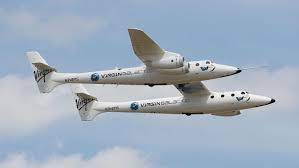The first paid customer voyage to the edge of space by Virgin Galactic since the firm was created by British entrepreneur Richard Branson in 2004 was a three-man crew from Italy traveling more than 50 miles (80 km) above the desert of New Mexico.
Three Virgin Galactic crew members, including two of whom piloted the vehicle, VSS Unity, once it was launched at great altitude from the belly of its twin-fuselage carrier plane, took the two Italian air force officers and an aerospace engineer from the National Research Council of Italy on the brief suborbital flight.
The Unity spacecraft successfully returned to its starting location on a runway at Spaceport America, a government-owned complex close to the appropriately named New Mexico town of Truth or Consequences, some 75 minutes after lifting off with its mothership. Part of the facility is leased by Virgin Galactic.
After nearly 20 years hampered by development failures Virgin Galactic Holding Inc., officially launched commercial operations with the flight, marking a long-delayed milestone.
In a project that developed out of the 2004 Ansari X Prize competition won by Rutan’s experimental spaceplane – a precursor to the SpaceShipTwo design of Unity – Branson launched the company with famous aerospace billionaire Burt Rutan.
Along with Jeff Bezos’ Blue Origin and fellow billionaire Elon Musk’s SpaceX, Virgin is the newest business catering to affluent customers willing to spend a lot of money to experience the thrill of supersonic rocket speed, microgravity, and the wonder of the Earth’s curvature from space.
SCIENCE MISSION IN ITALIA
However, the Italian team’s “Galactic 01” mission, which took off on Thursday, was advertised as a scientific one. The three men intended to gather biometric information, assess cognitive function, and document how specific liquids and solids combine in microgravity.
Colonel Walter Villadei of the Italian Air Force used the flight as practice for an upcoming trip to the International Space Station.
On Thursday, he was joined by two Italian coworkers: research council member Pantaleone Carlucci, who served as a flight engineer and payload specialist, and Air Force Lieutenant Colonel Angelo Landolfi, a doctor and flight surgeon.
Their Virgin Galactic instructor Colin Bennett, the company’s principal “astronaut instructor,” and Unity’s two pilots, Michael Masucci and Nicola Pecile, completed the crew.
Around 10:30 a.m. EDT (14:00 GMT), the carrier aircraft lifted off from Spaceport America near the New Mexico town of Truth or Consequences with the gleaming white rocket plane connected to the underside of its transport jet, VMS Eve.
Unity was detached from the mothership when it reached its launch-altitude point at about 45,000 feet (8.5 miles/13.68 km) above sea level. The pilots then ignited the rocket plane’s engine to send Unity streaking in a nearly vertical climb at about three times the speed of sound to the darkness of space.
Unity reportedly reached its highest point during flight at a height of around 52.9 miles (85.1 kilometers).
The crew then experienced a brief period of weightlessness at the flight’s peak when the rocket was shut off before the vehicle switched into re-entry mode and started floating back to Earth.
In a live webcast from Virgin Galactic, crew members were shown strapped into their seats, wearing flight suits, and sunglasses, enjoying the thrill of microgravity while Villadei unfurled an Italian flag inside the cabin as the trip approached its peak.
MODEL OF BUSINESS EVOLUTION
After Branson and five other Virgin Galactic employees flew on Unity’s first fully crewed test spaceflight in July 2021, the journey took place two years later. The company had set a goal for regular commercial service to start in 2022 after more test flights.
Prior to Thursday’s launch, the business had stated that a successful flight would open the door for Unity to take off once more in early August, followed by monthly flights.
According to Virgin Galactic, it has already secured a backlog of about 800 customers, with the majority paying between $250,000 and $450,000 per ticket. The company plans to eventually create a large enough fleet to support 400 trips per year.
It’s essential to build a strong safety reputation. One pilot was killed and another suffered major injuries when a previous version of the Virgin Galactic rocket jet crashed in 2014 while being tested over California’s Mojave Desert. A pre-flight waiver that acknowledges the dangers and the absence of government regulation around space travel is needed for all passengers.
The question of how far one must travel to engage in what is regarded as real spaceflight may also be relevant.
Bezos has criticized Virgin as falling short of the mark and has praised his astro-tourist company Blue Origin, which has already operated a number of commercial passenger flights.
Bezos claims that in contrast to Unity, Blue Origin’s suborbital New Shepard rocketship crosses the Karman line, a milestone established by an international aeronautics organization to mark the transition from Earth’s atmosphere to space, at a height of 62 miles (100 km).
Anyone who has flown at least 50 miles (80 km) in altitude is considered an astronaut, according to both NASA and the U.S. Air Force.

















